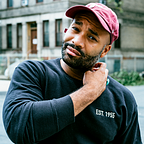Letters To My Daughters: Black Art As Revolution
Our art gets to inspire — and be inspired by — cultural and political shifts
I was on my second to last glass of whiskey. The hum of the ceiling fan gently cooed in my ears. I rocked you to sleep, slowly and silently, while Daniel Kaluuya, as Fred Hampton, finished the speech of a lifetime. Sweating and yelling to an engaged room of extras, he proclaimed, “I am a revolutionary!”
During that scene in Judas and the Black Messiah, I was a revolutionary, too. We all were as we took in the stained glass space of the 1969 Olivet Church. It’s where Hampton laid the groundwork for many of the black and white clips played during HBCU homecomings and Black History Month across the country. We watched Lakeith Stanfield and the entire cast from our sofas and safety nets as they embodied real-life humans who experienced deaths and suicides. We watched Dominique Fishback valiantly live in the skin of Akua Njeri, poet, activist, and chairperson of the December 4th Committee.
Judas and the Black Messiah felt like church, like a Panther meeting. That kind of dedication to artistry shows how art has the potential to push how we engage with our history and politics. It is no small feat. A Black actor who uses art to straddle the lines between performance and boots-to-the-ground…
